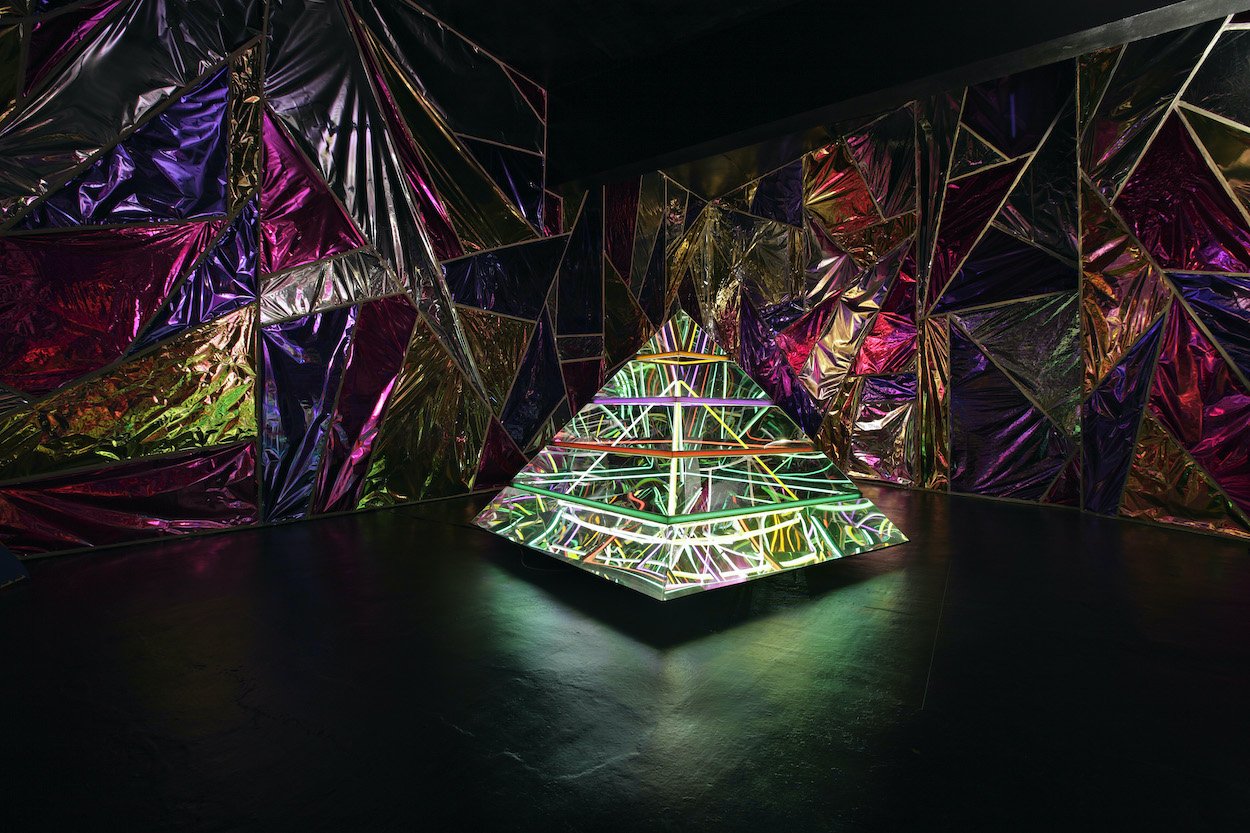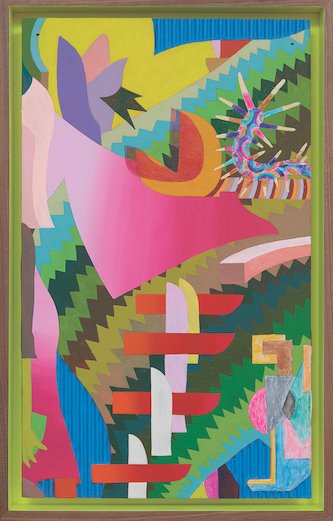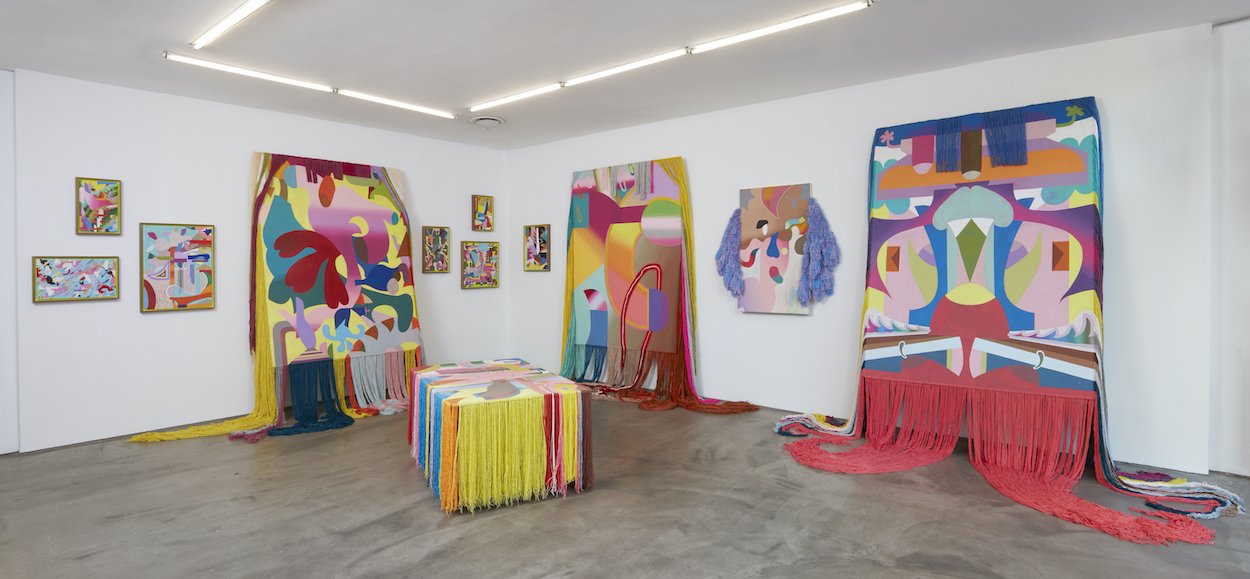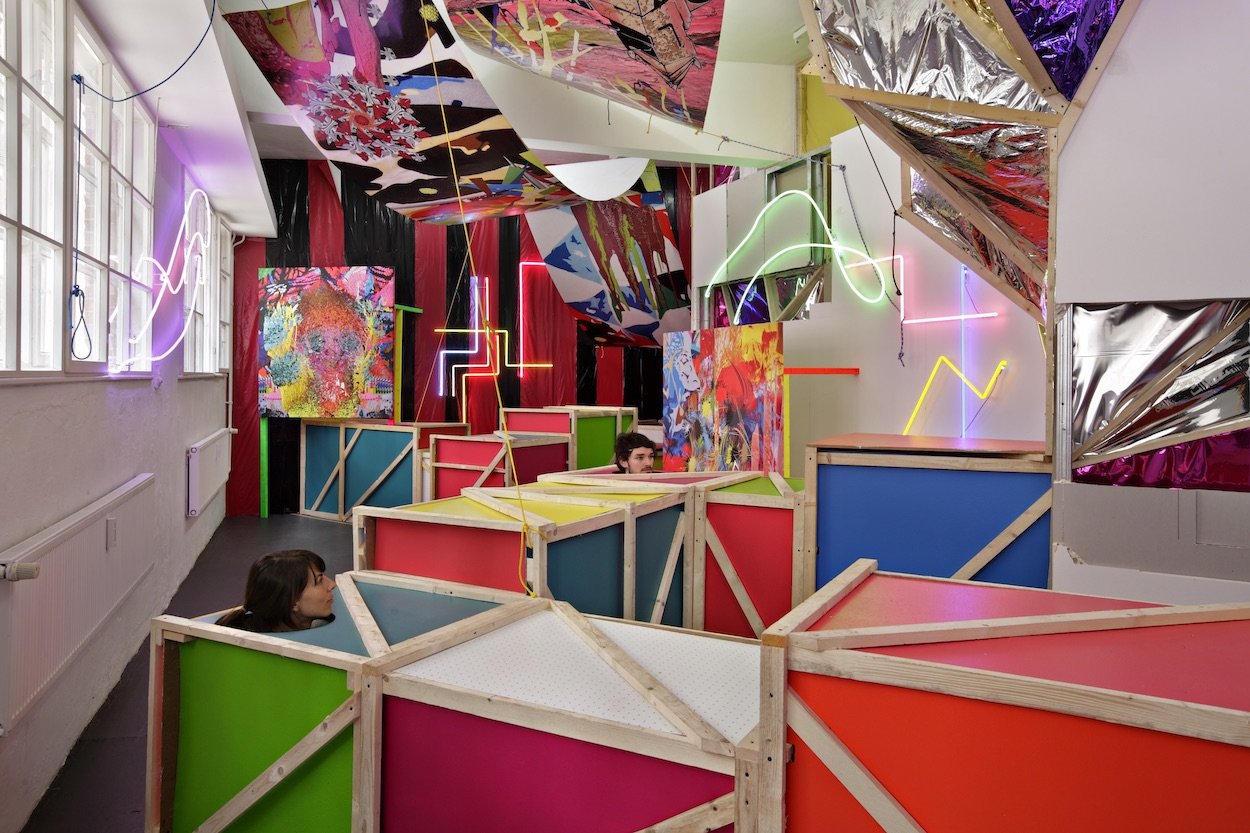Assume Vivid Astro Focus Rocks On
Published as “Life of the Party” in Art in America, November/December 2021
By Glenn Adamson
Assume vivid astro focus installation, Sao Paulo Bienal, 2008.
There are artists, there are artists’ collectives, and there is assume vivid astro focus. This entity (project? practice? platform? Its ontological status is purposely unclear) marks its twentieth anniversary this year, having been founded in New York City by Brazilian artist Eli Sudbrack. From the first, avaf was a radically open-ended endeavor. Even the name came by chance. “Astro” was occasioned by a case of mistaken identity in a secondhand clothing store; Sudbrack later discovered there was a makeup artist in the city by that name, who did in fact resemble him somewhat. He picked out the other words from “The LP Show,” a 2001 exhibition of more than 2,500 record covers curated by critic Carlo McCormick at Exit Art. Sudbrack collaged “Astro” with parts of the band name Ultra Vivid Scene and the title of Throbbing Gristle’s album Assume Power Focus.
It was a propitious time to rethink authorship. The dramatic growth of art stardom in the 1990s had produced an opposite (if not quite equal) effect, a widespread suspicion of the singular heroic figure. Suddenly, the field was crowded with collectives, among them the Vienna-based quartet Gelitin, whose members began working together in the mid-1990s; My Barbarian, formed in Los Angeles in 2000; Paper Rad, which operated in Pittsburgh and Providence from 2000 to 2008; and Bruce High Quality Foundation, founded in Brooklyn in 2004. These groups and others like them tend to have a certain elasticity, with participants coming and going. But avaf took that practice to extremes, embracing “contamination” as a guiding principle. From the beginning, various configurations of friends and collaborators have gathered together for the projects, with Sudbrack playing a role somewhat akin to George Clinton’s in the funk groups Parliament and Funkadelic, a central creative force who doesn’t necessarily need to be on stage. And at a time when gender-neutral language had not yet entered the mainstream, avaf was already positioning itself as a “they/them.” Sudbrack has written that he associates trans-ness with the idea of transgression, a “demolition of the everyday, of the expected, of the traditional, of comfort, of prejudice, of repression, of identity.”
View of the exhibition “aqui volvemos adornos frivolos,” 2008, at Peres Projects, Berlin.
PHOTO HANS-GEORG GAUL/COURTESY PERES PROJECTS
Initially, avaf insisted on absolute anonymity for all involved. The participants wore masks in public, and also handed them out to exhibition visitors. This idea was abandoned when they discovered that their mysterious identity was being fetishized in critical responses to their work—they had no interest in a Banksy-like manipulation of the celebrity game. But avaf continued to destabilize their own agency, in multiple ways. They generated large-scale graphic works, then distributed the digital files so that the images could be adapted by others. In an interview for this article, Sudbrack told me that he once heard secondhand about an avaf installation staged in Naples by the Italian shoe designer and art collector Ernesto Esposito. Sudbrack had no idea the show was going to happen, but he was thrilled. From 2005 through 2016, Sudbrack’s principal collaborator was French artist Christophe Hamaide-Pierson. Today they both work, separately and simultaneously, as assume vivid astro focus. Even that name, seemingly the only constant in this complicated author-function, is treated as fungible. In the titles of works, when signing off emails, and at seemingly every other opportunity, the artists substitute innumerable avaf aliases—a very anxious feeling, aimez vous avec ferveur, always vomit after formalities, or (self-parodically) acronyms validate artsy fartsies.
As one might expect, the artworks generated from this complex situationare highly variable in format and content. Working in many mediums—painting, video, performance, installation art, neon, and more—avaf seems as indiscriminately omnivorous as a search engine. Yet you wouldn’t mistake one of their creations for anything else. Everything made under the avaf banner has a maximalist aesthetic, usually with high-contrast, colliding, sometimes overlaid patterns. The effect is somewhat akin to that of 1980s postmodernism— Neo-Geo painting and the deconstructivist graphics of magazines like i-D and Emigre—but the pieces are even more energized, every surface densely populated with visual incident. Their immersive installations are particularly intense, resembling Op art– influenced discos; whenever possible, such works are actually used for dance parties, one way to “assure the viewer’s surrender,” as Sudbrack says, “turning the public into
one with our environments.” And even without celebrants, avaf’s colors are already a riot, a hyper-artificial palette. (For a few years, the collective’s preferred tool was an alcohol-based paint marker favored by graffiti artists, Krink K-60.) The hues seem to have jumped off a luminous flat-screen into real space. Transgender individuals make regular appearances, presiding like goddesses over this fluid aesthetic realm.
Deep Sea Visitor with a Purse Overlooking Green Corals and Bromelia, Flying Fish and Centipede (Snake Lipstick), 2021, acrylic and oil on corrugated duplex cardboard, 15 3/4 by 9 1/2 inches.PHOTO ALAN WEINER/COURTESY TIBOR DE NAGY, NEW YORK
If all this sounds remarkably prescient, you’re not wrong. Years prior to the rise of social media, avaf’s works anticipated viral memes in their infectiousness and malleability. The two most active members managed cross-continental collaboration (Hamaide-Pierson in Paris, Sudbrack in New York and São Paulo) without the help of Zoom or Skype. Long before the advent of NFTs, they were thinking of their work as a virtual type of intellectual property.
Avaf artists have also often been purposely indiscriminate in their means of production, sometimes employing craft-based processes, at others pushing right to the limits of technical possibility. In their early breakout work for the 2004 Whitney Biennial, they took the Skate Circle, a public roller-dance area in Central Park, for a canvas to which they applied an enormous printed vinyl “floor sticker,” a common application nowadays for large-scale projects but quite experimental at the time. They became conversant with digital design tools in the process and, for the past five years, almost every subsequent concept has derived from a single high-resolution file. Originally developed for a mask in the shape of a cat’s face, the design has been “remixed” into wallpaper, paintings, tapestries, and patterns for footwear; in effect, the image is like a digital archaeological site that avaf has been sifting through for new finds.
This past summer, the Tibor de Nagy Gallery presented avaf’s first exhibition in New York City in seven years. The show “Hairy What? Hairy How?” was atypical for them, beginning with its non-acronymic title. (It was an allusion, of course, to one of avaf’s acknowledged predecessors, the Hairy Who—the late 1960s Chicago-based group of Imagist painters). Visually, the presentation seemed to explode out into the street, thanks to the first-floor gallery’s big picture window. There were paintings large and small, all based on samples from the cat-mask pattern. At first the images seemed purely abstract, in the manner of works by Sonia Delaunay, perhaps, or Shirley Jaffe (whose ravishing geometric compositions are also shown at Tibor de Nagy). A moment’s examination, however, revealed another layer of imagery: comical phallic shapes barely hidden in the lush polychromatic jungle.
This was a recognizable avaf touch, as was the woolen fringe extending from the larger works, which expanded the colorful shapes into glam theatrical gestures. These paintings were definitely dressed to go out. In a further whimsical maneuver, the larger ones were mounted on ratcheted armatures, rather like the undercarriage of a deck chair, so that they could be tilted at various angles. One painting was set in the middle of the gallery like a table awaiting cocktails, its fringe hanging to the floor.
View of the exhibition “Hairy What? Hairy How?,” 2021, at Tibor de Nagy, New York.
Despite these many playful aspects, the show marked a departure from the all-in, immersive quality of the typical avaf experience. Since 2013, partly in response to the strain of long-term collaboration on projects that entail intense production effort, Sudbrack and Hamaide-Pierson have begun to devote more of their considerable energies to studio-based painting, even developing a system of some five hundred custom acrylic colors that Sudbrack thinks of as a “personal avaf Pantone.”
Yet the artists have hardly gone straight. The exhibition at Tibor de Nagy was just another refraction of their polymorphous, performative practice. The immediate pre-pandemic precedent for these works, in fact, was literally a celebration: the 2019 Roskilde Festival in Denmark. For the Nordic surroundings, avaf—on this occasion, the acronym for announcing victory as failure—programmed the dome-shaped House of Chroma with a trans-fusion of Brazilian street carnival, drag ball, and spoken word performance, all in the service of queerness and political critique. (“Often I think art should free itself from institutional environments,” Sudbrack has written, “and reinvent itself solely as a social project.”) A signature element of the ritualistic scenography was a set of “dancing tapestries,” with long multicolored tassels that spin into mesmerizing shapes when activated. Hybridizing craft, painting, and kinetic art, these works remind us that sophisticated abstraction was achieved in textiles many centuries before it emerged in European painting. Avaf’s tapestries also fly the flag for decorativeness and theatricality, refuting the marginalization of those categories.
Exhibition view, Peres Projects, Berlin, 2008.
Two decades in, assume vivid astro focus still emanate a youthful exuberance in all their activities. This winter, they’ll participate in the Thailand Biennale (December 18, 2021-March 31, 2022), reprising a set of skateboarding ramps that they first realized in Rio in 2016. Wherever they go next on their global itinerary, they’ll be bringing the party with them, for avaf’s project is perhaps understood as one long extended celebration, a raucous wake for the death of the author. In an art world starved for visual pleasure and newly motivated to embrace diversity, what could be more welcome than their brand of art: inclusive, hedonistic, and (I’m sure they’d want me to put it this way) as vibrant as fuck.




